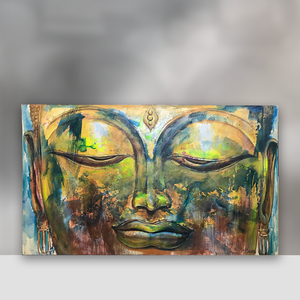Buddhist art is rich in symbolism and meaning, and one of the most fascinating aspects is the various hand gestures (mudras) and body postures (asanas) depicted in Buddhist sculptures and paintings. These gestures and postures are more than just artistic elements; they carry profound spiritual meanings and convey messages to viewers. In this article, we will explore some of the most common mudras and asanas in Buddhist art and understand their significance.
1. Dhyana Mudra
The Dhyana Mudra, also known as the meditation gesture, depicts the Buddha with his legs crossed and his hands in his lap. This gesture represents the deep meditation and concentration that leads to enlightenment. It reminds us that truth is found within, through the stillness of the mind.

Buddha decoration | Buddha statue | Wooden Buddha sculpture | Standing Buddha 30 cm
2. Abhaya Mudra
The Abhaya Mudra is the gesture of fearlessness and protection. The Buddha raises his right hand upward, facing forward, and rests his left hand on his lap. This gesture is meant to remind us that we need not fear the world if we pursue the path to enlightenment.
3. Bhumisparsha Mudra
The Bhumisparsha Mudra, also known as "Touching the Earth," depicts the Buddha touching the earth with his right hand while meditating with his left hand in his lap. This gesture commemorates the moment the Buddha attained enlightenment by calling upon the earth as a witness. It symbolizes determination and steadfast overcoming of obstacles.
4. Vitarka Mudra
The Vitarka Mudra, or "gesture of discussion," depicts the Buddha with his right hand raised, thumb and index finger touching, while his left hand rests in his lap. This gesture symbolizes the exchange of wisdom and teachings. It encourages us to share wisdom and strive for insight.
5. Padmasana
Padmasana, or lotus position, is a common posture of the Buddha. It represents calm, stability, and spiritual purity. The Buddha sits in the lotus position, indicating harmony and perfection of mind.

Buddha decoration | Teakwood Buddha | Wooden sculpture 50cm
6. Anjali Mudra
The Anjali Mudra, also known as the "greeting gesture," is performed by bringing the palms together in front of the chest. The fingers are parallel to each other, and the middle fingers are lightly touching. This gesture symbolizes respect and reverence. It encourages us to be humble and show respect for others and the spiritual. The Anjali Mudra is a gesture of prayer and reverence, expressing our devotion and appreciation.

7. Varada Mudra
Varada Mudra is a gesture symbolizing compassion and generosity. In this gesture, the right hand is held in front of the chest with the thumb and index finger clasped together, while the left hand usually rests on the thigh. This hand position expresses a willingness to give and show compassion. It emphasizes the qualities of kindness and generosity and reminds us to be compassionate and helpful. Varada Mudra is often used in conjunction with depictions of Buddhas or Bodhisattvas, as it embodies the idea of compassion and benevolence.
8. Vajra Mudra


9. Namaskara Mudra


Connect with the spiritual art
Would you like to experience the profound meaning of these mudras and asanas in your own environment? Visit our website and shop to discover a variety of Buddhist wooden sculptures embodying these gestures and postures. Each sculpture has been handcrafted with great care and attention to detail and carries the spiritual messages of Buddhist art.
Conclusion
The mudras and asanas in Buddhist art are not just aesthetic elements, but also spiritual symbols that convey profound wisdom and insight. If you would like to delve deeper into the world of Buddhist art, visit our website and be inspired by our unique wooden sculptures.
We hope this article has given you an insight into the fascinating world of mudras and asanas and that you will appreciate our products that embody these spiritual concepts.
Frequently asked questions about Mudras & Asanas in Buddhist art
What does the Dhyana Mudra mean for the Buddha?
The Dhyana Mudra represents deep meditation and spiritual concentration. It is often depicted on Buddha statues to symbolize inner peace and the quest for enlightenment.
Which mudra gives protection and strength?
The Abhaya Mudra—with the right hand raised—is considered a gesture of protection and fearlessness. It conveys a feeling of security and strength.
How do I choose a suitable Buddha sculpture for my home?
Consider what effect you desire: More tranquility? In that case, a Dhyana mudra is suitable. More protection or inspiration? In that case, Abhaya or Vitarka mudra are ideal. The size and choice of material also influence the effect of the room.
Are hand-carved wooden Buddha figures suitable for indoor and outdoor use?
Many of our wooden sculptures are designed for indoor use, but select models can also be placed outdoors with the right protection. Feel free to ask us for details!
What care do wooden Buddha sculptures need?
Wooden sculptures should be dusted regularly. A suitable wood oil is recommended once a year to keep the material supple and shiny.

